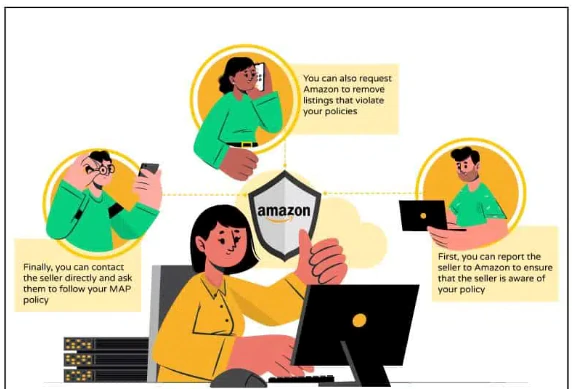What is Amazon Map Monitoring?
Amazon Marketplace is a key sales channel for millions of third-party sellers. However, ensuring your listings comply with Amazon’s policies is relevant to maintaining your selling privileges.
One complex area is MAP or minimum advertised pricing rules, which have started applying stringent monitoring over time. Also, learn about Amazon Firestick in this guide.
So sellers need to understand what it is and how to configure cost evaluations to avoid policy violations. Also, learn about Amazons GPT44X & Amazons GPT55x with this guide.
This guide will explain Amazon MAP monitoring and provide tips to keep your account in good standing.
What is MAP?
MAP stands for the minimum advertised price, which is a pricing policy set by some brands to protect product image and brand reputation.
Its policies dictate the official minimum tariff at which a product can be advertised or listed online.
The goal for brands is to prevent resellers from heavily discounting items and diluting the brand image. Discount rates can hurt the perception of quality and exclusivity.
Luxury brands in categories like cosmetics are especially cautious about these cost regulations.
THINGS TO CONSIDER
Real-time pricing data is the gold standard for MAP monitoring that is being used by many brands whose focus is providing customer-centric products.
How Amazon Monitors and Enforces MAP
Amazon uses a combination of automated bots and manual reviewers to monitor pricing across their marketplace for MAP compliance.
Any promotions found violating will trigger consequences on a legal level, resulting in blocking your brand.
The most common penalties include:
- Removal of the non-compliant listing
- Suspension or complete loss of selling privileges
- Trademark complaints filed by brands
In some cases, violations can also result in fines or being permanently blocked from selling certain brands. Given the severe outcomes, sellers must comply strictly with MAP policies.

Avoiding Amazon’s Pricing Bots
Automatic pricing Amazon uses 24/7, as it helps to monitor pricing and identify any cost violations.
These bots crawl all product listings continuously, flagging any rates below the legally fixed levels.
When a violation is detected, the bots will immediately remove that brand’s ads. Since the automated monitoring is constant, any inventory priced below MAP will be caught quickly.
Tips to avoid issues with Amazon’s pricing bots:
- Research and comply with the official MAP pricing for each brand you sell. This information should be provided directly from the manufacturer. Try to avoid assumptions of tariffs at any level.
- Price at or slightly above the MAP cost evaluation minimums. Do not set tariffs significantly lower, even if there is competition. The bots scan specifically for below MAP rates.
- If you must lower the costs due to market conditions, use struck-through rates to display the MAP and the lower tariff. But do not advertise the lower cost publicly.
- Expect faster enforcement on major brands like Apple that are very strict about discounting. Tread carefully with premium brands.
- If you receive a violation warning, immediately adjust your rates to comply with the minimum advertised tariffs. Be aware that repeated issues can lead to the loss of selling privileges.
DO YOU KNOW?
More than 60% of sales in the Amazon store come from independent sellers—most of which are small and medium-sized businesses.
Appealing Erroneous MAP Violations
In some cases, you may receive MAP violation warnings in error. If you believe your rates meet the brand’s pricing guidelines, you can request an appeal.
Provide proof of the official MAP pricing directly from the manufacturer. Explain how your brand’s inventory aligns with the legally fixed cost rules.
However, note that Amazon heavily favors brands in disputes. Appeals are not always successful.
The graph below shows the global distribution of new sellers on the Amazon Marketplace in 2020, by country.

Passing Manual Reviews
In addition to bots, Amazon employs manual reviewers to audit listings for MAP compliance. These human reviewers sample product pages, looking for non-compliant pricing.
Follow these guidelines to pass manual reviews:
- Never use text like “lower price in cart” or “see price when added to cart” as these advertise below MAP.
- Avoid text and graphics highlighting discounts or strike-through pricing. Use plain text at or above MAP.
- Ensure your inventory tariff matches the one that is mentioned at the checkout. Discounts only at checkout violate MAP.
- Review your entire sales channel for MAP compliance, including external websites, other marketplaces, and retail stores.

Maintaining Compliance Long-Term
Complying fully with MAP guidelines requires diligence but protects your seller account. Brands prefer consistent pricing and the ability to control discounting.
Best practices for maintaining long-term MAP compliance:
- Frequently check brand sites and seller portals for policy updates and rate changes. Adjust your inventory accordingly.
- Use repricing software to automate changes, but configure rules to uphold MAP minimums. Never set automated costs below regulatory levels.
- When sales or promotions push you to discount, use vouchers or coupon codes instead of reducing the list price. Keep your headline costs regulatory compliant.
- Review inventory periodically, both new products and existing inventory, to catch any MAP issues quickly.
Conclusion
Following Amazon’s requirements takes work but enables stable marketplace selling. Despite the complexities, strict MAP monitoring and enforcement is the norm for the platform.
Staying informed on brand terms and configuring listings appropriately is significant for sellers.
With some diligence, you can successfully sell profitably on Amazon while upholding MAP and avoiding violations.
